Band (rock and pop)
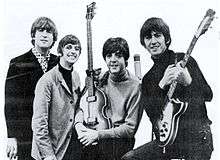
A rock band or pop band is a small musical ensemble which performs rock music, pop music or a related genre. The four-piece band is the most common configuration in rock and pop music. Before the development of the electronic keyboard, the configuration was typically two guitarists (a lead guitarist and a rhythm guitarist, with one of them singing lead vocals), a bassist, and a drummer (e.g. Avenged Sevenfold, KISS, Franz Ferdinand). Another common formation is a vocalist who does not play an instrument, electric guitarist, bass guitarist, and a drummer (e.g. The Who, The Monkees, Led Zeppelin, Queen, and U2). Instrumentally, these bands can be considered as trios.
The smallest ensemble that is commonly used in rock music is the trio format. Two-member rock and pop bands are relatively rare, because of the difficulty in providing all of the musical elements which are part of the rock or pop sound (vocals, chords, bass lines, and percussion or drumming). In a hard rock or blues-rock band, or heavy metal rock group, a "power trio" format is often used, which consists of an electric guitar player, an electric bass guitar player and a drummer, and typically one or more of these musicians also sing (sometimes all three members will sing, e.g. Bee Gees or Alkaline Trio). Some well-known power trios with the guitarist on lead vocals are The Jimi Hendrix Experience, Stevie Ray Vaughan and Double Trouble, Nirvana, The Jam, and ZZ Top.
Two members
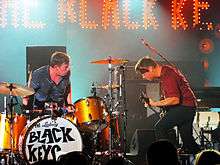
Two-member rock and pop bands are relatively rare, because of the difficulty in providing all of the musical elements which are part of the rock or pop sound (vocals, chordal accompaniment, bass lines, and percussion or drumming). Two-member rock and pop bands typically omit one of these musical elements. In many cases, two-member bands will omit a drummer, since guitars, bass guitars, and keyboards can all be used to provide a rhythmic pulse.
Examples of two-member bands are Japandroids, The Lightning Strikers, Local H, Pet Shop Boys, Hella, Flight of the Conchords, Death from Above 1979, Francis Xavier, I Set My Friends on Fire, Middle Class Rut, The Pity Party, Little Fish, The White Stripes, Big Business, Two Gallants, Lightning Bolt, The Ting Tings, The Black Box Revelation, Satyricon, The Black Keys, Tenacious D, Simon and Garfunkel, Hall & Oates, Twenty One Pilots, Johnossi, The Pack A.D. and Royal Blood.
When electronic sequencers became widely available in the 1980s, this made it easier for two-member bands to add in musical elements that the two band members were not able to perform. Sequencers allowed bands to pre-program some elements of their performance, such as an electronic drum part and a synth bass line. Two-member pop music bands such as Soft Cell, Blancmange and Yazoo used pre-programmed sequencers. Other pop bands from the 1980s which were ostensibly fronted by two performers, such as Wham!, Eurythmics and Tears for Fears, were not actually two-piece ensembles, because other instrumental musicians were used "behind the scenes" to fill out the sound.
Two-piece bands in rock music are quite rare. However, starting in the 2000s, blues-influenced rock bands such as The White Stripes and The Black Keys utilized a guitar and drums scheme. However, this is predated by the Flat Duo Jets and House of Freaks from the 1980s. Death from Above 1979 featured a drummer and bass guitarist. Tenacious D is a two-guitar band; One Day as a Lion and The Dresden Dolls both feature a keyboardist and a drummer. The band Welk consists of a two-man psychedelic flute band, with the occasional synthesizer. Two-person bands have grown in popularity in experimental rock music. Ratatat are a two-guitar band that utilize a drum machine for beats. W.A.S.P. guitarist Doug Blair is also known for his work in the two-piece progressive rock band signal2noise, where he acts as the lead guitarist and bassist at the same time, thanks to a special custom instrument he invented (an electric guitar with five regular guitar strings paired with three bass guitar strings). Heisenflei of Los Angeles duo The Pity Party plays drums, keyboards, and sings simultaneously. Providence-based Lightning Bolt is a two-member band. Bassist Brian Gibson augments his playing with delay pedals, pitch shifters, looping devices and other pedals, occasionally creating harmony parts. Local H, Blood Red Shoes, PS I Love You, The Redmond Barry's and Warship are other prominent two-person experimental rock bands. Founded in 2013 Royal Blood is an unusual example of a two-piece band that uses bass and drums, relying on extensive use of electronic effects to produce a 'fuller' sound.
Three members
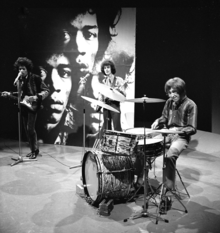
The smallest ensemble that is commonly used in rock music is the trio format. In a hard rock or blues-rock band, or heavy metal rock group, a "power trio" format is often used, which consists of an electric guitar player, an electric bass guitar player and a drummer, and typically one or more of these musicians also sing (sometimes all three members will sing, e.g. Bee Gees or Alkaline Trio). Some well-known power trios with the guitarist on lead vocals are The Jimi Hendrix Experience, Stevie Ray Vaughan and Double Trouble, Nirvana, Green Day, Violent Femmes, Gov't Mule, The Minutemen, James Gang, Triumph, Shellac, Sublime, Chevelle, Muse, The Jam, Stray Cats, and ZZ Top.
A handful of others with the bassist on vocals include Primus, Motörhead, The Police, The Melvins, MxPx, Blue Cheer, Rush, The presidents of the United States of America, Venom, and Cream.
Some power trios feature two lead vocalists. For example, in the band blink-182 vocals are split between bassist Mark Hoppus and guitarist Tom DeLonge, or in the band Dinosaur Jr., guitarist J. Mascis is the primary songwriter and vocalist, but bassist Lou Barlow writes some songs and sings as well.
An alternative to the power trio are organ trios formed with an electric guitarist, a drummer and a keyboardist. Although organ trios are most commonly associated with 1950s and 1960s jazz organ trio groups such as those led by organist Jimmy Smith, there are also organ trios in rock-oriented styles, such as jazz-rock fusion and Grateful Dead-influenced jam bands such as Medeski Martin & Wood. In organ trios, the keyboard player typically plays a Hammond organ or similar instrument, which permits the keyboard player to perform bass lines, chords, and lead lines, one example being hard rock band Zebra. A variant of the organ trio are trios formed with an electric bassist, a drummer and an electronic keyboardist (playing synthesizers) such as the progressive rock band Emerson, Lake & Palmer, Triumvirat, and Atomic Rooster. Another variation is to have a vocalist, a guitarist and a drummer, an example being Yeah Yeah Yeahs. Another variation is two guitars, a bassist, and a drum machine, examples including Magic Wands and Big Black. Progressive metal band Animals as Leaders has two guitarists and a drummer. Both guitarists, Tosin Abasi and Javier Reyes, use seven and eight string guitars in their music for an extended range. This allows for bass-playing techniques to be utilised on the lower strings in order to compensate for the lack of bass guitar.
The Mini Mansions features drummer Michael Shuman as their frontman. Shuman does not use a bass drum, but instead incorporates electronic drum pads into his kit. The band also uses a keyboardist, Tyler Parkford, and a bass player, Zach Dawes. Parkford and Shuman share lead vocal duties, occasionally duetting, or handing off vocal duties to a guest vocalist such as Alex Turner or Fred Schneider. Shuman will also occasionally play lead guitar, utilising a relay-like system, in which he will begin the drum part himself, passing the 'baton' to a drum machine while playing guitar riffs and/or solos, then returning to his kit when finished. Dawes will also occasionally switch with Shuman, and play drums while Shuman plays guitar or bass.
A power trio with the guitarist on lead vocals is a popular record company lineup, as the guitarist and singer will usually be the songwriter. Therefore, the label only has to present one "face" to the public. The backing band may or may not be featured in publicity. If the backup band is not marketed as an integral part of the group, this gives the record company more flexibility to replace band members or use substitute musicians. This lineup often leads to songs that are fairly simple and accessible, as the frontman (or frontwoman) will have to sing and play guitar at the same time.
Four members

The four-piece band is the most common configuration in rock and pop music. Before the development of the electronic keyboard, the configuration was typically two guitarists (a lead guitarist and a rhythm guitarist, with one of them singing lead vocals), a bassist, and a drummer(e.g. The Beatles, KISS, Jackyl, Metallica, The Clash, Creedence Clearwater Revival, The Kinks, The Fray, Sonic Youth, The Smashing Pumpkins, Arctic Monkeys, Franz Ferdinand). This is popular with bands for its versatility.
Another common formation is a vocalist, electric guitarist, bass guitarist, and a drummer (e.g. Tool, The Who, The Monkees, Led Zeppelin, Queen, Ramones, Sex Pistols, Red Hot Chili Peppers, Soundgarden, R.E.M., Blur, The Smiths, Echo and the Bunnymen, The Stone Roses, Creed, Black Sabbath, Van Halen, Rage Against the Machine, The Stooges, Joy Division, and U2). Instrumentally, these bands can be considered as trios. This format is popular with new bands, as there are only two instruments that need tuning, the melody and chords formula prevalent with their material is easy to learn, four members are commonplace to work with, the roles are clearly defined and generally are: instrumental melody line, rhythm section which plays the chords and/or countermelody, and vocals on top.
In some early rock bands, keyboardists were used, performing on piano (e.g. The Seeds and The Doors) with a guitarist, singer, drummer and keyboardist. Some bands will have a guitarist, bassist, drummer, and keyboard player (for example, Talking Heads, Gerry and the Pacemakers, Small Faces, The Stranglers, King Crimson, The Guess Who, Pink Floyd, Queen, Coldplay, The Killers and Blind Faith).
Some bands will have the bassist on lead vocals, such as Thin Lizzy, The Chameleons, Skillet, Pink Floyd, Motörhead, NOFX, +44, Slayer, The All-American Rejects or even the lead guitarist, such as Death, Dire Straits, Megadeth and Creedence Clearwater Revival. Some bands, such as The Beatles, have a lead guitarist, a rhythm guitarist and a bassist that all sing lead and backing vocals, that also play keyboards regularly, as well as a drummer. Others, such as The Four Seasons, have a lead vocalist, a lead guitarist, a keyboard player, and a bassist, with the drummer not being a member of the band.
Five members
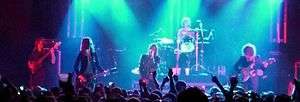
Five-piece bands have existed in rock music since the development of the genre. The Beach Boys, The Rolling Stones (until 1993), Aerosmith, Def Leppard, The Runaways (until 1977), AC/DC, Oasis, Pearl Jam, Guns N' Roses, Radiohead, The Strokes, The Yardbirds, 311, My Chemical Romance and The Hives are examples of the common vocalist, lead guitar, rhythm guitar, bass, and drums lineup. An alternative to the five-member lineup replaces the rhythm guitarist with a keyboard–synthesizer player (examples being the bands Journey, Elbow, Dream Theater, Genesis, Jethro Tull, Kasabian, The Zombies, The Animals, Bon Jovi, Yes, Snow Patrol, Fleetwood Mac, Marilyn Manson and Deep Purple, all of which consist of a vocalist, guitarist, bassist, keyboardist, and a drummer) or with a turntablist such as Deftones, Hed PE, Incubus or Limp Bizkit. Pink Floyd, during the recordings for their second album - A Saucerful of Secrets -, even consisted of five musicians at once, when guitarist David Gilmour joined the band as Syd Barrett's mental health began to decline. However, Syd quit the band during the album recording and it turned back to a quartet, Gilmour having assumed the guitar for good.
Alternatives include a keyboardist, guitarist, drummer, bassist, and saxophonist, such as The Sonics, The Dave Clark 5, and Sam the Sham and the Pharaohs. Another alternative is three guitarists, a bassist and a drummer, such as Radiohead and The Byrds. Some five-person bands feature two guitarists, a keyboardist, a bassist and a drummer, with one or more of these musicians (typically one of the guitarists) handling lead vocals on top of their instrument (examples being Children of Bodom, Styx, The Music Machine, Relient K, Ensiferum and the current line up of Status Quo). In some cases, typically in cover bands, one musician plays either rhythm guitar or keyboards, depending on the song (one notable band being Firewind, with Bob Katsionis handling this particular role).
Other times, the vocalist will bring another musical "voice" to the table, most commonly a harmonica or percussion; Mick Jagger, for example, played harmonica and percussion instruments like maracas and tambourine. Ozzy Osbourne was also known to play the harmonica on some occasions (i.e. "The Wizard" by Black Sabbath). Vocalist Robert Brown of lesser known steampunk band Abney Park plays harmonica, accordion, and darbuka in addition to mandolin. Flutes are also commonly used by vocalists, most notably Ian Anderson of Jethro Tull and Ray Thomas of the Moody Blues.
A less common lineup is to have lead vocals, two guitarists of varying types and two drummers, e.g. Adam and the Ants.
Larger rock ensembles
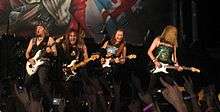
Larger bands have long been a part of rock and pop music, in part due to the influence of the "singer accompanied with orchestra" model inherited from popular big-band jazz and swing and popularized by Frank Sinatra and Ella Fitzgerald. To create larger ensembles, rock bands often add an additional guitarist, an additional keyboardist, additional percussionists or second drummer, an entire horn section, and even a flautist. An example of a six-member rock band is Toto with a lead vocalist, guitarist, bassist, two keyboard players, and drummer. Other examples include Australian band INXS and American Blondie; both they consist in a lead vocalist, two guitarists, a keyboard player, a bassist and a drummer. The American heavy metal band Slipknot is composed of nine members, with a vocalist, two guitarists, a drummer, a bassist, two custom percussionists, a turntablist, and a sampler.
In larger groups (such as The Band), instrumentalists could play multiple instruments, which enabled the ensemble to create a wider variety of instrument combinations. More modern examples of such a band are Arcade Fire and Edward Sharpe and the Magnetic Zeros. More rarely, rock or pop groups will be accompanied in concerts by a full or partial symphony orchestra, where lush string-orchestra arrangements are used to flesh out the sound of slow ballads. Rhys Chatham and Glenn Branca started doing performances in the late 1970s with orchestras consisting of ten to hundred (Branca) and even four hundred guitars.[1] Some groups have a large number of members that all play the same instrument, such as guitar, keyboard, horns or strings.
Role of women

Women have a high prominence in many popular music styles as singers. However, professional women instrumentalists are uncommon in popular music, especially in rock genres such as heavy metal. "[P]laying in a band is largely a male homosocial activity, that is, learning to play in a band is largely a peer-based... experience, shaped by existing sex-segregated friendship networks.[2] As well, rock music "...is often defined as a form of male rebellion vis-à-vis female bedroom culture."[3] In popular music, there has been a gendered "distinction between public (male) and private (female) participation" in music.[3] "[S]everal scholars have argued that men exclude women from bands or from the bands'rehearsals, recordings, performances, and other social activities."[4] "Women are mainly regarded as passive and private consumers of allegedly slick, prefabricated – hence, inferior – pop music..., excluding them from participating as high status rock musicians."[4] One of the reasons that there are rarely mixed gender bands is that "bands operate as tight-knit units in which homosocial solidarity – social bonds between people of the same sex... – plays a crucial role."[4] In the 1960s pop music scene, "[s]inging was sometimes an acceptable pastime for a girl, but playing an instrument...simply wasn't done."[5]
"The rebellion of rock music was largely a male rebellion; the women—often, in the 1950s and '60s, girls in their teens—in rock usually sang songs as personæ utterly dependent on their macho boyfriends...". Philip Auslander says that "Although there were many women in rock by the late 1960s, most performed only as singers, a traditionally feminine position in popular music". Though some women played instruments in American all-female garage rock bands, none of these bands achieved more than regional success. So they "did not provide viable templates for women's on-going participation in rock".[6]:2–3 In relation to the gender composition of heavy metal bands, it has been said that "[h]eavy metal performers are almost exclusively male"[7] "...[a]t least until the mid-1980s"[8] apart from "...exceptions such as Girlschool."[7] However, "...now [in the 2010s] maybe more than ever–strong metal women have put up their dukes and got down to it",[9] "carv[ing] out a considerable place for [them]selves."[10] When Suzi Quatro emerged in 1973, "no other prominent female musician worked in rock simultaneously as a singer, instrumentalist, songwriter, and bandleader".[6]:2 According to Auslander, she was "kicking down the male door in rock and roll and proving that a female musician ... and this is a point I am extremely concerned about ... could play as well if not better than the boys".[6]:3
References
- ↑ Chatham
- ↑ Julian Schaap and Pauwke Berkers. "Grunting Alone? Online Gender Inequality in Extreme Metal Music" in Journal of the International Association for the Study of Popular Music. Vol.4, no.1 (2014) p. 101-102
- 1 2 Julian Schaap and Pauwke Berkers. "Grunting Alone? Online Gender Inequality in Extreme Metal Music" in Journal of the International Association for the Study of Popular Music. Vol.4, no.1 (2014) p. 102
- 1 2 3 Julian Schaap and Pauwke Berkers. "Grunting Alone? Online Gender Inequality in Extreme Metal Music" in Journal of the International Association for the Study of Popular Music. Vol.4, no.1 (2014) p. 104
- ↑ Erika White (28 January 2015). "Music History Primer: 3 Pioneering Female Songwriters of the '60s | REBEAT Magazine". Rebeatmag.com. Retrieved 2016-01-20.
- 1 2 3 Auslander, Philip (28 January 2004). "I Wanna Be Your Man: Suzi Quatro's musical androgyny" (PDF). Popular Music. United Kingdom: Cambridge University Press. 23 (1): 1–16. doi:10.1017/S0261143004000030. Retrieved 25 April 2012.
- 1 2 Brake, Mike (1990). "Heavy Metal Culture, Masculinity and Iconography". In Frith, Simon; Goodwin, Andrew. On Record: Rock, Pop and the Written Word. Routledge. pp. 87–91.
- ↑ Walser, Robert (1993). Running with the Devil:Power, Gender and Madness in Heavy Metal Music. Wesleyan University Press. p. 76.
- ↑ Eddy, Chuck (1 July 2011). "Women of Metal". Spin. SpinMedia Group.
- ↑ Kelly, Kim (17 January 2013). "Queens of noise: heavy metal encourages heavy-hitting women". The Telegraph.